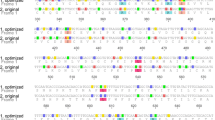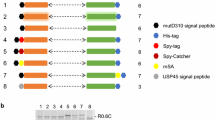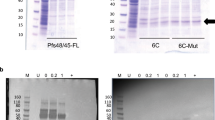Abstract
Rabies virus infection remains a serious public health threat in the developing world, where cost-concerns make wide-scale public health interventions impractical. The development of novel and inexpensive ELISA diagnostic antigens is critical in early detection and prevention of complications. The transmembrane glycoprotein (G) of rabies virus (RV) contains an external domain capable of inducing the synthesis of anti-rabies, virus-neutralizing antibodies, in infected or immunized hosts. In our study, the external G domain was synthesized and fused in-frame with a polyhistidine-tag coding sequence present in the expression plasmid. Soluble truncated recombinant G was secreted in Hansenula polymorpha (H. polymorpha) using H. polymorpha-derived calnexin (HpCNE1) overproduction and found to be correctly N-glycosylated. The truncated recombinant G was purified from cell culture supernatant by Ni-agarose affinity chromatography and when compared with the full-length glycoprotein, found to be similarly immunogenic in vaccinated rabbits. These results subsequently led us to explore the potential of truncated recombinant G as a diagnostic antigen in ELISA. Our results show that the truncated recombinant G can detect antibodies directed to both whole virion and native glycoprotein. More sophisticated applications of truncated recombinant G would profit from the correctly N-glycosylated and soluble monomer.
Similar content being viewed by others
References
Ashraf, S., Singh, P.K., Yadav, D.K., Shahnawaz, M., Mishra, S., Sawant, S.V., and Tuli, R. 2005. High level expression of surface glycoprotein of rabies virus in tobacco leaves and its immunoprotective activity in mice. J. Biotechnol.119, 1–14.
Barth, R., Diderrich, G., and Weinmann, E. 1988. NIH test, a problematic method for testing potency of inactivated rabies vaccine. Vaccine6, 369–377.
Bradford, M.M. 1976. A rapid and sensitive method for the quantitation of microgram quantities of protein utilizing the principle of protein-dye binding. Anal. Biochem.72, 248–254.
Damasceno, L.M., Anderson, K.A., Ritter, G., Cregg, J.M., Old, L.J., and Batt, C.A. 2007. Cooverexpression of chaperones for enhanced secretion of a single-chain antibody fragment in Pichia pastoris. Appl. Microbiol. Biotechnol.74, 381–389.
Doms, R.W., Lamb, R.A., Rose, J.K., and Helenius, A. 1993. Folding and assembly of viral membrane proteins. Virology193, 545–562.
Ellgaard, L., Molinari, M., and Helenius, A. 1999. Setting the standards: Quality control in the secretory pathway. Science286, 1882–1888.
Faber, K.N., Haima, P., Harder, W., Veenhuis, M., and Ab, G. 1994. Highly-efficient electrotransformation of the yeast Hansenula polymorpha. Curr. Genet.25, 305–310.
Gaudin, Y., Ruigrok, R.W., Tuffereau, C., Knossow, M., and Flamand, A. 1992. Rabies virus glycoprotein is a trimer. Virology187, 627–632.
Gellissen, G., Kunze, G., Gaillardin, C., Cregg, J.M., Berardi, E., Veenhuis, M., and van der Klei, I. 2005. New yeast expression platforms based on methylotrophic Hansenula polymorpha and Pichia pastoris and on dimorphic Arxula adeninivorans and Yarrowia lipolytica — a comparison. FEMS Yeast Res.5, 1079–1096.
Gongal, G. and Wright, A.E. 2011. Human rabies in the WHO Southeast Asia region: Forward steps for elimination. Adv. Prev. Med. (article in press) DOI: 10.4061/2011/383870.
Gupta, P.K., Sharma, S., Walunj, S.S., Chaturvedi, V.K., Raut, A.A., Patial, S., Rai, A., Pandey, K.D., and Saini, M. 2005. Immunogenic and antigenic properties of recombinant soluble glycoprotein of rabies virus. Vet. Microbiol.108, 207–214.
Ishikawa, Y., Samejima, T., Nomura, Y., Motohashi, T., Orima, T., and Tasaka, K. 1989. Immunogenicity of an inactivated vaccine prepared from the cell culture-adapted RC-HL strain of rabies virus. J. Jpn. Vet. Med. Assoc.42, 715–720.
Klabunde, J., Kleebank, S., Piontek, M., Hollenberg, C.P., Hellwig, S., and Degelmann, A. 2007. Increase of calnexin gene dosage boosts the secretion of heterologous proteins by Hansenula polymorpha. FEMS Yeast Res.7, 1168–1180.
Klepfer, S.R., Debouck, C., Uffelman, J., Jacobs, P., Bollen, A., and Jones, E.V. 1993. Characterization of rabies glycoprotein expressed in yeast. Arch. Virol.128, 269–286.
Laemmli, U.K. 1970. Cleavage of structural proteins during the assembly of the head of bacteriophage T4. Nature227, 680–685.
Morrissey, J.H. 1981. Silver stain for proteins in polyacrylamide gels: a modified procedure with enhanced uniform sensitivity. Anal. Biochem.117, 307–310.
Parlati, F., Dominguez, M., Bergeron, J.J., and Thomas, D.Y. 1995. Saccharomyces cerevisiae CNE1 encodes an endoplasmic reticulum (ER) membrane protein with sequence similarity to calnexin and calreticulin and functions as a constituent of the ER quality control apparatus. J. Biol. Chem.270, 244–253.
Perrin, P., Thibodeau, L., and Sureau, P. 1985. Rabies immunosome (subunit vaccine) structure and immunogenicity. Pre- and post-exposure protection studies. Vaccine3, 325–332.
Prehaud, C., Takehara, K., Flamand, A., and Bishop, D.H. 1989. Immunogenic and protective properties of rabies virus glycoprotein expressed by baculovirus vectors. Virology173, 390–399.
Rath, A., Choudhury, S., Batra, D., Kapre, S.V., Rupprecht, C.E., and Gupta, S.K. 2005. DNA vaccine for rabies: Relevance of the trans-membrane domain of the glycoprotein in generating an antibody response. Virus Res.113, 143–152.
Rutkevich, L.A. and Williams, D.B. 2011. Participation of lectin chaperones and thiol oxidoreductases in protein folding within the endoplasmic reticulum. Curr. Opin. Cell. Biol.23, 157–166.
Sakamoto, S., Ide, T., Tokiyoshi, S., Nakao, J., Hamada, F., Yamamoto, M., Grosby, J.A., Ni, Y., and Kawai, A. 1999. Studies on the structures and antigenic properties of rabies virus glycoprotein analogues produced in yeast cells. Vaccine17, 205–218.
Sauerbrei, A. and Wutzler, P. 2006. Serological detection of varicella-zoster virus-specific immunoglobulin G by an enzyme-linked immunosorbent assay using glycoprotein antigen. J. Clin. Microbiol.44, 3094–3097.
Shakin-Eshleman, S.H., Remaley, A.T., Eshleman, J.R., Wunner, W.H., and Spitalnik, S.L. 1992. N-linked glycosylation of rabies virus glycoprotein. Individual sequons differ in their glycosylation efficiencies and influence on cell surface expression. J. Biol. Chem.267, 10690–10698.
Singh, R.P., Sreenivasa, B.P., Dhar, P., Shah, L.C., and Bandyopadhyay, S.K. 2004. Development of a monoclonal antibody based competitive-ELISA for detection and titration of antibodies to peste des petits ruminants (PPR) virus. Vet. Microbiol.98, 3–15.
Song, H., Li, Y., Fang, W., Geng, Y., Wang, X., Wang, M., and Qiu, B. 2003. Development of a set of expression vectors in Hansenula polymorpha. Biotechnol. Lett.25, 1999–2006.
Warrell, M.J. and Warrell, D.A. 2004. Rabies and other lyssavirus diseases. Lancet363, 959–969.
Wildt, S. and Gerngross, T.U. 2005. The humanization of N-glycosylation pathways in yeast. Nat. Rev. Microbiol.3, 119–128.
Wojczyk, B.S., Takahashi, N., Levy, M.T., Andrews, D.W., Abrams, W.R., Wunner, W.H., and Spitalnik, S.L. 2005. N-glycosylation at one rabies virus glycoprotein sequon influences N-glycan processing at a distant sequon on the same molecule. Glycobiology15, 655–666.
Yelverton, E., Norton, S., Obijeski, J.F., and Goeddel, D.V. 1983. Rabies virus glycoprotein analogs: Biosynthesis in Escherichia coli. Science219, 614–620.
Zhang, Y., McAtee, P., Yarbough, P.O., Tam, A.W., and Fuerst, T. 1997. Expression, characterization, and immunoreactivities of a soluble hepatitis E virus putative capsid protein species expressed in insect cells. Clin. Diagn. Lab. Immunol.4, 423–428.
Author information
Authors and Affiliations
Corresponding author
Additional information
Supplemental material for this article may be found at http://www.springerlink.com/content/120956.
Electronic supplementary material
Rights and permissions
About this article
Cite this article
Qian, W., Aguilar, F., Wang, T. et al. Secretion of truncated recombinant rabies virus glycoprotein with preserved antigenic properties using a co-expression system in Hansenula polymorpha . J Microbiol. 51, 234–240 (2013). https://doi.org/10.1007/s12275-013-2337-0
Received:
Accepted:
Published:
Issue Date:
DOI: https://doi.org/10.1007/s12275-013-2337-0




